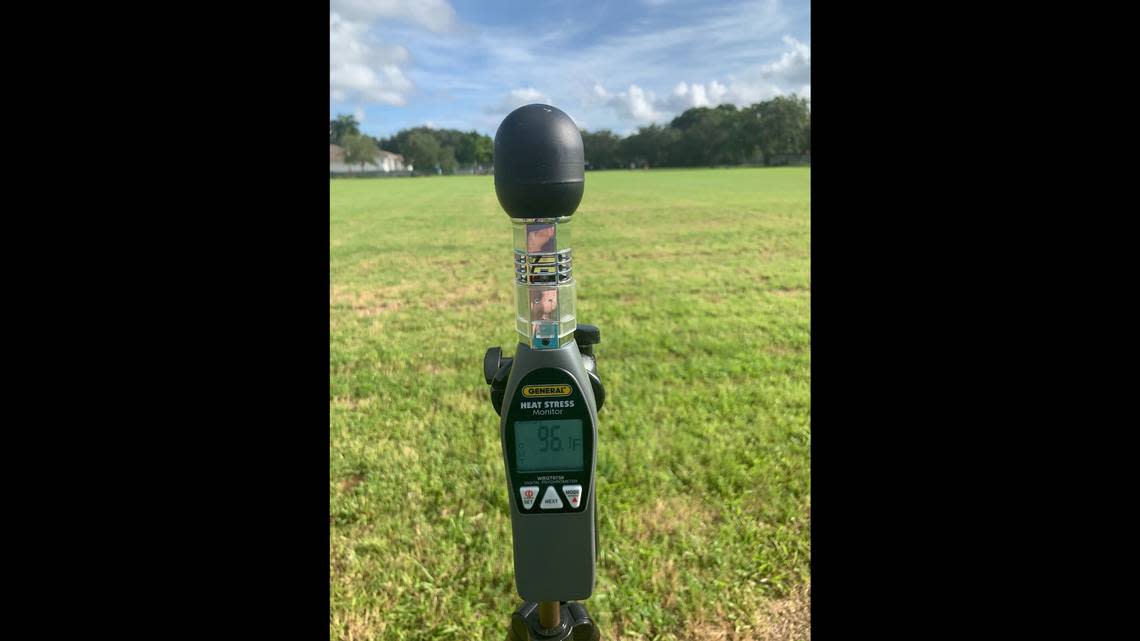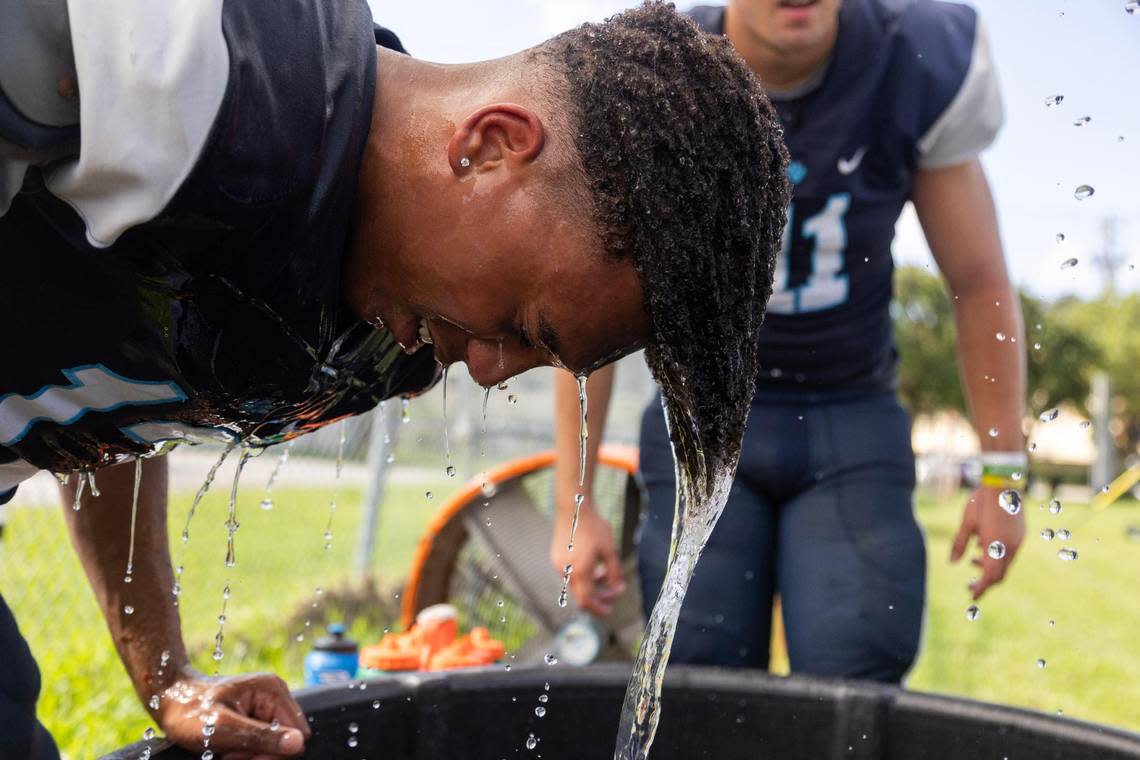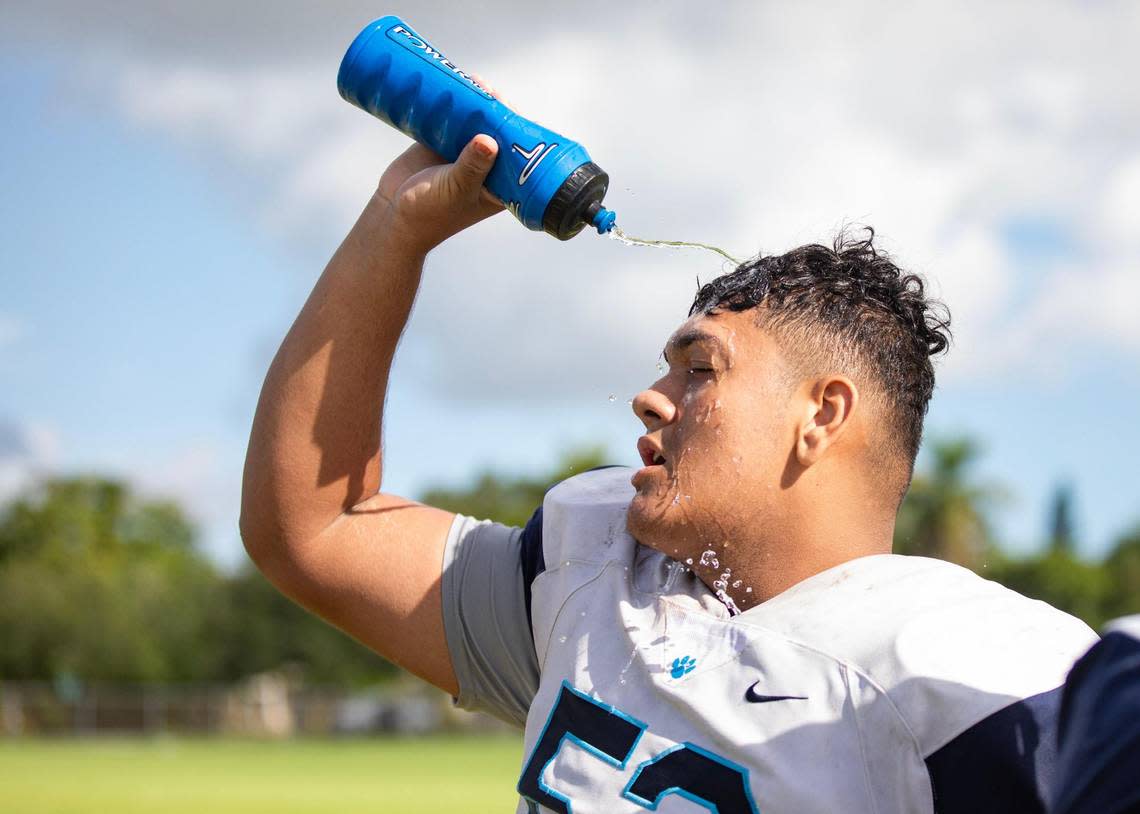Miami’s hot weather is changing football practice. What it looks like at Palmetto High
Gavin Mortazavi rushed off the football field during break to dunk his head into a bath of icy water.
“It feels amazing in this hot weather,” he said, as other teammates splashed their heads in the tub during Monday’s early morning football practice at Miami Palmetto Senior High School in Pinecrest.
The ice-filled cooling tub — described by Palmetto’s athletic trainer as the “gold standard” to treat heat-related illnesses — is one of several preventative measures schools across the state are using to help keep their athletes safe from muscle cramps, heat exhaustion and heat stroke.
Florida made ice baths mandatory for public schools after the death of 16-year-old Riverdale football player Zachary Martin. The Lee County high school student collapsed of heat stroke during football practice in 2017 and later died. The Zachary Martin Act, signed into law by Gov. Ron DeSantis in 2020, also has other heat-related mandates, including requiring schools to have automated external defibrillators readily available in case of an emergency and annual training for coaches and staff on how to identify, prevent and respond to exertional heat illness.
In South Florida, where heat advisories and warnings have become the norm this summer, the risk of student athletes overheating has risen.
“Never have we started to record on day one in the fall, summer practice, the temperatures that we’re dealing with right now,” said Michele Benz, head athletic trainer at Miami Palmetto Senior High School in Pinecrest and a member of the sports medicine advisory committee of the Florida High School Athletic Association.
The high school uses a state-mandated wet bulb thermometer to measure “ambient temperature, humidity, the radiant sun and the wind,” to help staff determine if any precautionary heat measures are needed, Benz said. In previous years, the hottest temperatures recorded were in the high 80s. Now, the athletic trainer is recording temperatures in the 90s.
And the school isn’t taking any chances. Coaches are holding earlier practices, more water breaks, and teaching students what symptoms to look out for.
So, what does football practice look like in South Florida’s sweltering heat? Here’s a glimpse:
Monitoring the heat

The wet bulb globe thermometer helps staff determine whether any heat precautionary measures are needed. Modifications can include more water breaks, telling students to take off their helmets, or in the most extreme case, suspending or shortening practice.
At least one practice has been canceled so far because of the heat.
READ NEXT: These symptoms could be a sign of heat stroke. What to know during Miami’s hot weather
Mist and ice baths

At Palmetto, where students practice in an open field, tents provide shelter from the sun during water breaks. The tent is where football players gather to drink Gatorade, water and get relief from the heat. The tent has a fan and mist, new features implemented by staff this year to help their athletes keep cool. And the effects are felt immediately.
Athletes can also dunk their heads, arms, towels — or their entire body — into the ice bath.
“Honestly, it’s a lifesaver,” said football player Daniel Fandino.
On Monday, under Benz’s watchful eyes, offensive lineman Jordan Stewart slowly submerged himself into the ice bath to help cool down his body. Benz later sat him near the fan and patted his face with a wet towel before taking him into the school to rest in air conditioning.
READ MORE: Some medications can increase risk of heat exhaustion, heat stroke. Here’s what to know
Rules for practice
Here are the rules for practice:
▪ If the thermometer reading is less than 82.0, practices can be held with at least three separate water breaks, each of at least 3 minutes, per hour.
▪ If the reading is between 82.2 and 86.9, each break must increase to four minutes.
▪ Between 87.1 and 90.0, players are limited to wearing helmets, shoulder pads and shorts. Practice can be up to 2 hours.

▪ At 90.1-91.9, practice can only be one hour, there can be no conditioning exercises and no protective equipment can be used.
▪ At 92.1 or higher, no outdoor practices can be held.
Benz said it’s not an immediate practice stoppage if temperatures hit a certain mark because they often fluctuate with clouds and wind. However, she keeps an eye on the thermometer, and if there’s no dip, it’s time to make modifications.
Football players the Herald spoke with said they’re grateful for the precautions and don’t really notice the heat when out on the field, which for Benz and her team, is a win.
“During the play, you don’t notice it [the heat]. But once everything starts to cool down, you’re starting to get to go back to the huddle, that’s the hardest part, after or before the play, that’s when you notice the heat but during the play, you don’t notice it,” said defensive back Lawrence Johnson.
Miami Herald staff writer Meadow Barrow contributed to this report.
